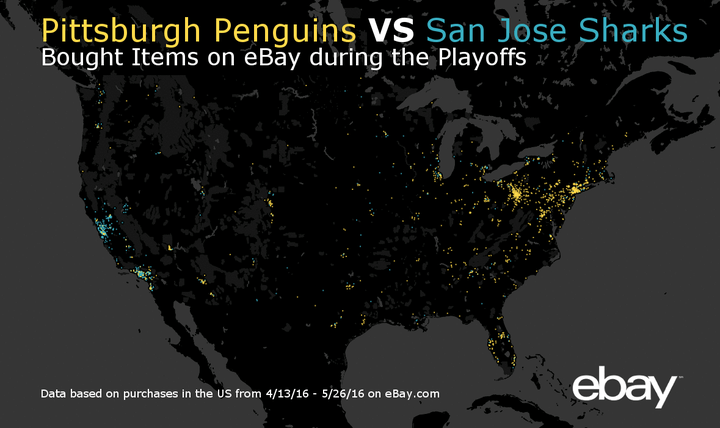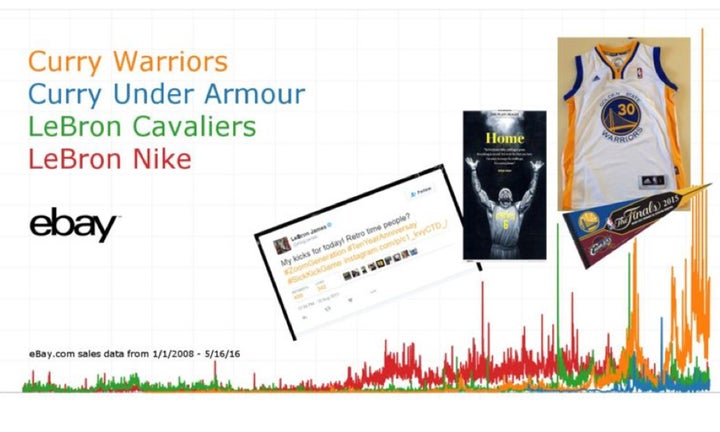In April and May of this year, eBay tracked buyers’ purchasing behaviors and looked for patterns in how they were affected by a unique set of events - the San Francisco Bay area had a team in both the NBA (Golden State Warriors) and the NHL (San Jose Sharks) simultaneously. Based on mounds of data, eBay produced some interesting (and beautiful) GIFs for the purchasing behavior of team-related memorabilia (and that of rivals) across the U.S.
As might be expected, there were some clear patterns. The Pittsburgh Penguins (rivals to the Sharks) clearly had a bigger fan-purchasing base across the U.S., mainly concentrated in the northeast, Georgia, and Florida - and purchases went up as game day approached. While the Warriors’ popularity spread in CA in 2016, the Cleveland Cavaliers remained the more popular team (according to purchasing behavior) across the U.S.

The NBA match also inspired a longer-term look at purchasing trends correlating with specific events associated with the the Cavaliers’ and Warriors’ respective players, LeBron James and Stephen Curry, who are considered by some as rivals. eBay created a unique graph of buyer behavior related to the two athletes’ teams and sponsored brands, tracing purchases made between January 2008 and May 2016.
There are clear spikes that correspond with real-world events. For example, a moderate increase in Cavalier-related purchases correlate with Lebron’s 10-year celebration (in 2013) of his first Nike shoe, and even more significant buying jumps in Warriors-related gear occurred when Curry was named Most Valuable Player in 2016.

The visualized trend of buyers’ patterns is interesting, but what’s the real benefit of this type of big data analysis for retailers? It would seem that zooming in on the micro level (the individual) is a more important consideration in the “big data” era of personalization, and eBay’s VP, Chief Data Officer Zoher Karu, would seem to agree.
In one of TechEmergence’s recent interviews exploring the implications of machine learning for business, Karu said: “Make sure that your data is actually organized around your customer. Most businesses, especially those starting, have their data oriented by store or by country or by region or by channel…but they won’t have the data organized by customer...really understanding things from a customer perspective will go a long way toward allowing you to treat different customers differently.”
Of course, as the world’s largest online retail marketplace, eBay is in a unique position to use big data in a variety of ways (even if it doesn’t necessarily yield an immediate revenue increase), including helping to visualize buying trends that would otherwise likely have remained invisible to human eyes. eBay has enough data that they can look beyond the individual level, if for nothing else than the interest factor, though there’s likely more to these visualizations than meets the eye.
It’s important to keep in mind that big data is all about better decision-making, and having a good idea of what information or solution you’re looking for is essential to any business looking to use machine learning as a tool. It can shed surprising insights or suggest new patterns of thought, but in general most mid-size or smaller businesses are using big data and machine learning to accomplish a specific goal.
In general, big data is more or less shallow in its ability to get at the individual buyer’s or even small groups’ behavior. For the most part, retailers can only observe what was purchased, but not why they made those purchases. On the contrary, this is exactly what makes eBay’s study so interesting i.e. their ability to correlate purchases with external events on a national level.
While big data may not be the best tool for making strategic marketing decisions (insight is likely better gleaned at the “small data” level), big data (paired with predictive analytics) is useful for making more tactical decisions i.e. fine-tuning prices and searching for cross-selling opportunities, as well as monitoring sales cycles to adjust stocks and promote high-value items at particular times and/or in particular regions.
When it comes to implementing machine learning tools, recommendation engines are widely used at a more individualized level, but Zoher (and others) believe that the machine learning potential for individuals or small groups doesn’t stop at product recommendations. “Take the homepage of eBay or any website - could a machine auto layout that for every person as opposed to a human saying I’ll put this here, etc.? There will be a combination of human-assisted machines, is the way I think about it,” Zoher stated.
It seems likely that one day, companies will be able to leverage machines to better understand consumers, and translate that from everything to page layout to smarter virtual shopping assistants. At present, analyzing social media content and behavior has attracted interest from some retailers, though this type of analysis is not quite within reach.
“There have been a lot of companies that have tried different attempts at understanding behavior on social platforms…those are challenging, a lot of those conversations are not necessarily about commerce intent, they’re just conversations,” said Zoher. This is just one area that, at present, largely requires a human mind to make inferences; it’s still a challenge to determine when a machine might be able to draw such subtle inferences and make sense of desires that are unstated or spoken “between the lines”.
One important and oft talked-about future area for advancement in retail and business is cognitive computing platforms, which will be able to not only analyze and find patterns in data, but draw insights and combine the two into a more holistic prediction/guide map for business needs. While ‘simple’ versions of cognitive computing platforms exist today, the primary difference between current systems and those of the future is the idea of machines providing future action steps that are predicated on predictive data sources, not just historical data sources.
Even if (or when) this day arrives, humans will likely still play a major role as collaborator in interacting and exchanging feedback with these smart systems before any hard-and-fast decisions are implemented; however, having a “super-human” virtual mind in the mix will certainly leverage humans’ abilities to give customers more of what they might not have even been aware that they wanted.
